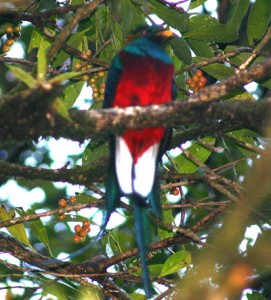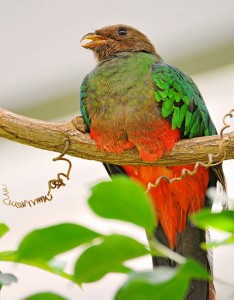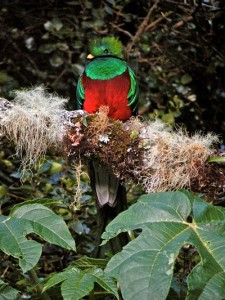With stunning, inimitable plumage and grace, the Quetzal is named for its splendor. The Aztec word, quetzalli, was used for this bird’s tail feathers, and also meant “precious,’ or “beautiful.’ This shy trogon has a large population in Costa Rica. This bird is endangered because the cloud forest on which it depends has been extensively destroyed. The legendary tail feathers that can be three or more feet long are one of the telltale signs of the male Resplendent Quetzal. Adult Quetzals have a grey and black striped tail, and are covered in shimmering green on the head, back, and wings, so they blend into the wet foliage of the cloud forest. The females have somewhat similar plumage, but lack the green crest and bright red breast of the males, as well as the elongated tail feathers. Any trip to the Costa Rican forest will not be complete without a Quetzal sighting.
Remember that travel agents can use 60-Second Geography articles on their websites and in their newsletters!
Be sure to check out the special offers on the self-drive trips to Quetzal country with Solar Tours after the article.
|
60-Second Geography
The Home Of The Quetzal
|
| If you are on a Quetzal hunt, Playa Dominical (Dominical Beach), located to the South of Quepos, might be a good base camp. It has a laid back atmosphere where you can unwind, enjoy some great wildlife, tropical plants, waterfalls, and if you are so inclined, some world class surfing, kayaking, snorkeling, diving, fishing and trekking. Dominical Beach is a reasonable drive to most of the areas where you may spot a Quetzal. |
- Juan Castro Blanco National Park. One of the lesser explored parks in Costa Rica, Juan Castro Blanco National Park, is positioned in the center of various destinations. This bird-watching haven is located northwest of the Central Valley, with the Poas Volcano to the southeast and Braulio Carrillo National Park to the east. Juan Castro Blanco National Park provides an excellent opportunity to see incredible primary and rain forests, which make up 50% of the park.
- Chirripo National Park. Nestled along the heart of the Talamanca Mountain Range in the south central portion of Costa Rica, Chirripo National Park consists of 123,923 acres and provides one of the best opportunities to test your hiking abilities. Trails throughout the park take you as high as you want to go, ultimately reaching the highest peak in the country and second highest in Central America. The ascent to Cerro Chirripo at 12,532 ft. is definitely a test of endurance and a favorite among avid nature enthusiasts.
- Braulio Carrillo National Park. Getting its name from Costa Rica’s third president, Dr. Braulio Carrillo, the national park, full of tropical rainforest, spans northeast of the Central Valley. Flowing down from the Central Volcanic Corridor, Braulio Carrillo National Park falls between the Poas Volcano to the west and the Irazu Volcano to the east. The protected zone encompasses 108,970 acres of rolling hills crammed with dark-green vegetation that teems with wildlife.
- Poas Volcano National Park. Considered by most to be one of the most breathtaking sites in the entire country, the Poas Volcano sits high above 14,000 acres of various habitats and life zones which make up Poas Volcano National Park. Rising up to 8,885 ft, Poas remains one of Costa Rica’s largest and most active volcanoes. This fact alone is enough to attract thousands of visitors per year.
- Monteverde Cloud Forest Reserve. The Monteverde Cloud Forest Reserve is one of the best-kept secrets for Quetzel spotting. Monteverde is a cloud forest, not a rain forest, due to its elevation of 4,724 ft above sea level. Some of the best bird-watching can be done inside and outside the reserve.
- Santa Elena Cloud Forest Reserve. The Santa Elena Cloud Forest Reserve is the less visited sister reserve of the Monteverde Cloud Forest Reserve. Just 4 miles from the center of Santa Elena lies this less crowded eco-utopia full of lush green forests full of flora and fauna. This reserve boasts one of the best places to hear and see howler monkeys in all of Costa Rica.
|
 |
|
 |
|
 |
|
|
© Copyright 2010 Travmarket. LLC. |
|
|
|
|
Self Drive Itineraries to Home of Quetzal Area – Costa Rica From Solar Tours
|

|
|
|
|
|
| Travel Agents: You can use the content above on your own website or newsletter, compliments of the supplier sponsor above who has paid for your use of the materials. All you need to do is to follow the directions in the TRO Licensing Agreement. Also, please take a moment to check out the travel supplier that makes your use of this material possible.To use – Follow the procedure outlined in the TRO Licensing Agreement. Then, right click on this page and choose “View Source”. Copy the HTML and paste the copied HTML into your own web pages or newsletter. You may remove advertising. |







